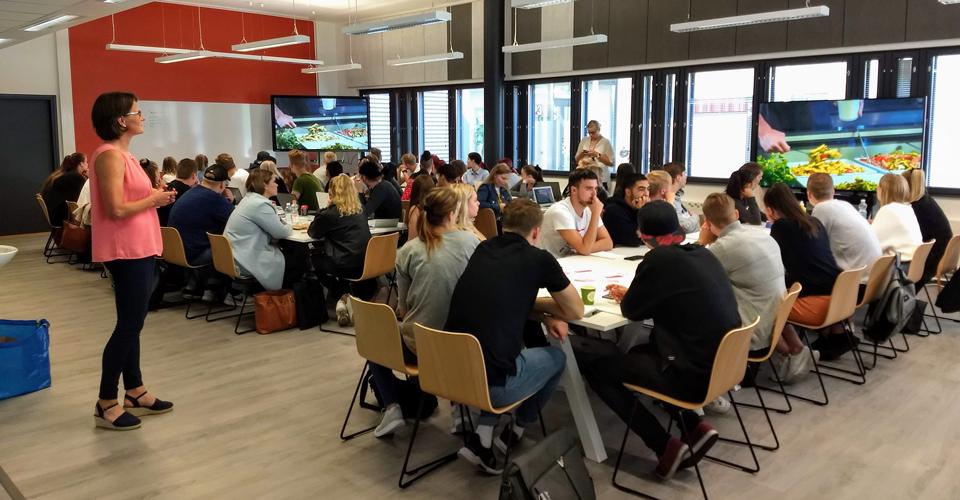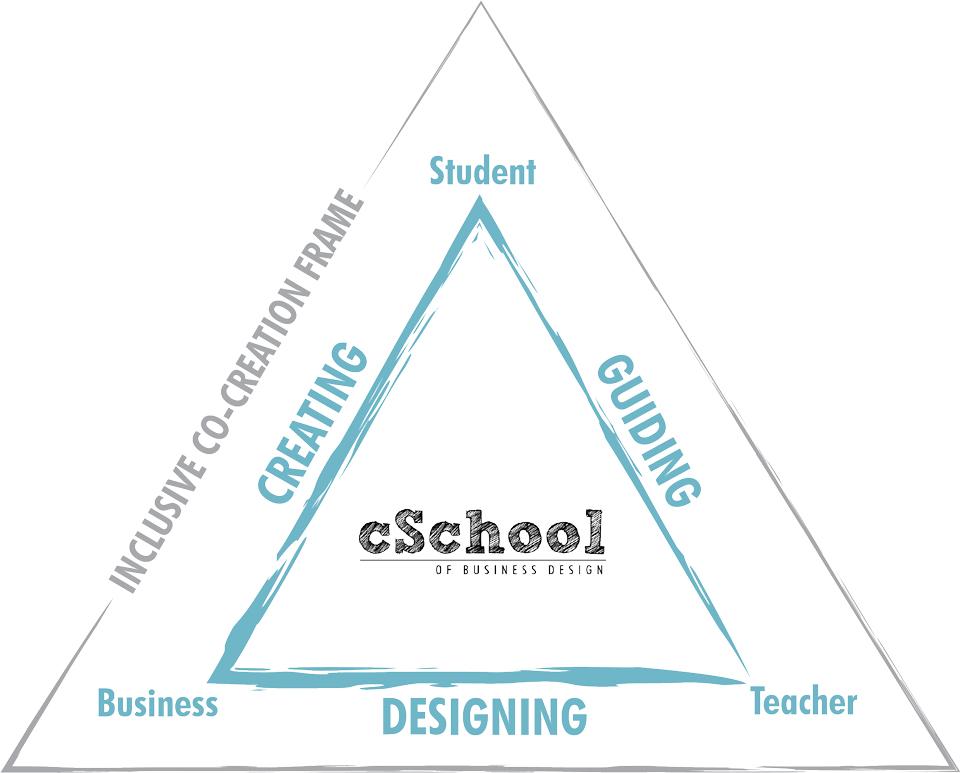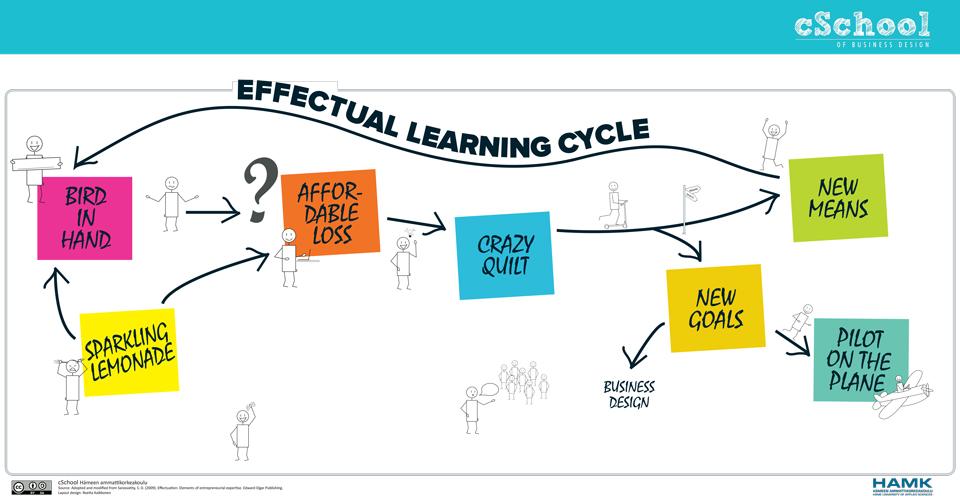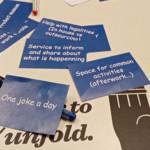
Irma Kunnari, Jari Jussila, Vesa Tuomela & Jukka Raitanen
In building engaging learning in a changing world, we need to rethink our pedagogy and be ready to co-create it all the time. Co-creation pedagogy relies on students’ ownership for their learning, and teachers’ facilitating role, all involved stakeholders in the learning ecosystem are active contributors. In this kind of process, you need to be really present and available, master the uncertainty and focus on potentials and possibilities.
In this article, we share what has been learned in HAMK cSchool in developing inspiring practices how to learn entrepreneurial knowledge, skills, and attitude in a safe environment and at the same time experiencing excitement, inspiration, unknown, uncertainty, potential failure, learning and success. In the name of HAMK cSchool, c refers to Can do School where learners’ full potentials are aspired to unlock in authentic business design, marketing and data-driven business development.
Our aim is to discuss key principles of HAMK cSchool to be utilized in the development of HAMK Design Factory. As the pedagogy cannot be modelled as something fixed but evolving, we wanted to name it as co-creation pedagogy.
Innovative higher education at HAMK
Due to rapid changes and discontinuities in the world of work, the demands for professional expertise are continually changing. There is a need for multitalented people that have expertise not only from one discipline, but several, and who can also apply that knowledge in practice (Ahokallio-Leppälä, 2016). HAMK’s vision is to be the most inspiring and the most workplace-oriented university of applied sciences in Finland (HAMK, 2019).
In 2014, HAMK restructured the curricula by integrating traditional subjects into bigger competence-based modules, which also necessitated teachers’ teamwork and students’ peer learning as well as intensive work-life connections. HAMK has also pioneered in establishing several project-based learning (PBL) environments. PBL initiatives that included service design and prototype development for various companies include, for example, ‘muotoilutori’ (Hakkarainen & Tuominen, 2006), ‘starttihautomo’ (Hannula & Pajari-Stylman, 2008), AutoMaint Network Factory (Heikkilä, Horelli, & Väänänen, 2009; Väänänen, 2012), ‘Konseptori’ (Lehto, 2013) and open design environment Wisain (Seddiki & Lundahl, 2015). HAMK cSchool of Business design started in 2015, to provide an innovative environment to learn entrepreneurial skills and most recently Design Factory was established to strengthen interdisciplinary passion-based learning.
HAMK cSchool as a real-world learning environment
HAMK cSchool has built a real-world environment for students to develop their competencies. Biggs and Tang (2007) highlight the idea of constructive alignment, in which the learners themselves construct knowledge, and in which the learning and assessment practices, as well as learning environments, need to be aligned with the targeted learning outcomes. A good learning environment makes the user feel smart by providing pedagogical scaffolding and enabling interaction in various, pedagogically meaningful ways (Lonka, 2018, p. 42). HAMK cSchool relies on collaborative knowledge construction culture instead of relying on an individual knowledge construction culture of learning (e.g. Hakkarainen, Palonen, Paavola, & Lehtinen, 2004; Lonka, 2015). The starting point of cSchool can be traced in the recognition that traditional schooling is not enough for developing competencies relevant to the rapidly changing world of work. In cSchool, students are not just accomplishing school tasks for teachers, but they are solving meaningful real-life challenges and learning relevant competencies during projects.
During the lifespan of cSchool, there has been continuous co-creation of pedagogical practices utilizing open interaction and collaboration. Rather than just a study module, cSchool is seen as an entity that always needs three parties, students, teachers and business (Figure 1). The guiding principle has been to work and to learn in a real-life context, where not everything can be planned in advance, but each stakeholder involved need to go out of their comfort zone and master the uncertainty. Each process is unique regarding the operations done and stakeholders that have been active. This can be seen as the demand-driven education, which takes the changing needs of learners and the world of work into account (Koenen, Dochy, & Berghmans, 2015). Relevancy and meaningfulness for all the stakeholders are created during the process.

Business challenges are often ambiguous, unpredictable and messy with a lot of unknown (Faljic, 2019) and therefore very seldom, there exists one single solution for the challenge. Because of the ambiguous nature of the challenges, business design methodologies, tools and mindset offer a good approach for multidisciplinary teams to solve them. Company people themselves are often learners in cSchool projects. They do now know the solution and are willing to get ideas and concepts from and with students. In the most successful business challenges of cSchool, the business partners own the problem and besides, they are actively developing the project with the teachers and students, continuously steering the project towards better results.
An inclusive frame of co-creation pedagogy
HAMK cSchool learning process implementation consists of a variety of methods and tools corresponding to the real-life work environments. The development of students’ competencies and business solutions is supported by continuous documentation, critical and analytical interaction in open digital environments as well as during face-to-face learning moments. All the stakeholders are working together in the digital collaboration environment. Usually, students as key stakeholders design and select the specific tools they use and how they use them. The information is easily accessible at any time. Students can also send their own questions and materials to the same digital environment, allowing them to contribute and thus being able to be real co-creation partners in the process. In this kind of inclusive frame, not only students but all active business partners and teachers are learners and contributors from their own starting point. There is freedom to act for all.
Inclusiveness is also supported by teamwork and team learning. Both students and teachers work as a team. Student teams have weekly meetings with the staff so that they will get help during the different stages of projects. During the meetings, the students present the state they are currently at and discuss their further steps with the teacher team. Furthermore, a very important principle is freedom to ask, which means that students can come to meet teachers at all times during the project work and get instructions to their problems. Freedom to ask also refers to the open door policy of cSchool and to the business partners from whom the projects are received. Teams are responsible that no-one is left behind.
Active and inclusive interaction operates as the base of co-creation in cSchool. Freedom to act means that you can contribute to the process and you need to be ready for new ideas. Not all the actions can be planned in advance but inclusiveness requires that unexpected confrontations are approached with an open mind. In its best, all the stakeholders’ actions may cluster together resulting in resource gains and upward spirals, as gain spirals, in individuals as well as in their communities (Hakanen, Perhoniemi, & Toppinen-Tanner, 2008). These kinds of gain spirals increase motivation and engagement (Hobfoll, 2001).
Students at the core in co-creation pedagogy
Co-creation pedagogy of HAMK cSchool leans on student-centredness and competence-based education. The foundation of student-centred learning is based on sociocultural and socio-constructivist ideas of learning (e.g. Lave & Wenger, 1991; Salomon & Perkins, 1998; Vygotsky, 1978), which highlight students’ ownership in their own learning. Learners are leading their learning by constructing a new understanding. Prior knowledge plays an important role. Learning is facilitated by social interaction and meaningful learning occurs with authentic tasks. Similar aspects can be found in the principles of competence-based education (CBE). According to Koenen, Dochy and Berghmans (2015), the common characteristics illustrating CBE are realistic tasks and authentic settings, students’ own responsibility of the learning process, a reflection of learning by students, teachers’ facilitating role, and competence-based assessment methods.
Students’ leadership in their own learning process is both a tool and the end result as an important life-long learning competence. According to Spences and Juliani (2017), students’ ownership of their own learning brings creativity and self-directedness. Students learn project management and develop iterative thinking and growth mindset. They learn to experiment and think outside the box. When students own their learning, they become problem-solvers and view mistakes as learning opportunities. They become explorers and are ready for the global creative economy. (Spences & Juliani, 2017) Similar empowering aspects can be found in HAMK cSchool practices when students have started to lead their learning.
Teachers as co-creative facilitators
HAMK cSchool teacher-facilitators are co-creating their work continuously to sustain the relevancy in supporting learning. This entails a growth mindset instead of a fixed one (see Dweck, 2012). According to previous research related to teacher learning in the change (Kunnari, 2018), growth mindset of teachers requires a holistic approach to students’ learning, attunement to the needs of students, alignment of pedagogical practices according to the targeted competencies, flexibility to organize learning processes utilizing resources available and relying on collaboration with all the stakeholders. In HAMK cSchool, teachers create space for students to take learning into their own hands.
The most relevant task for teachers is to empower students with a holistic approach for students growth. In their guidance practices, teachers build circumstances for pedagogical wellbeing, preconditions for students to feel competent and have a sense of autonomy and relatedness (Kunnari & Lipponen, 2010; Ryan & Deci, 2000). Teachers are genuinely interested in students as individuals, who they are, what they are good at and what their personal interests are. This builds a foundation for meaningful learning when students can experience that they are being seen and heard. Teachers give their visions and support to make learning happen. In continuously living and evolving learning communities of students and business partners, teachers are changing towards feeders and operators that support success and development (Feld, 2012). They focus is on unlocking students’ full potentials.
Co-creation pedagogy following effectuation principles
In HAMK cSchool, it has been recognized that many educational and entrepreneurial theories for learning have many similarities. When developing successful pedagogy, it is good to use design principles that work in practice.
A foundation of entrepreneurial learning has been defined in the concept of entrepreneurship, “the ability of an individual to transform ideas into operations” (Shane, 2004). Also, entrepreneurial process from intention to opportunity searching and discovering, decision to exploit opportunity and finally exploiting the opportunity (Shane, 2004) is largely a doing, making and acting-oriented process emphasizing learning.
In co-creation pedagogy, many analytical tools are exploited to facilitate the learning process and to make all the stakeholders needs and capacities transparent. For example:
- double loop design journey (van der Pijl, Lokitz, Solomon, van der Pluijm, & van Lieshout, 2016);
- double diamond design model (Design Council, n.d.);
- design thinking (Meinel & Leifer, 2011);
- customer journey canvas (Stickdorn, Schneider, Andrews, & Lawrence, 2011);
- service blueprint (Bitner, Ostrom, & Morgan, 2008);
- business model canvas (Osterwalder & Pigneur, 2010); and
- lean service creation canvases (Sarvas, Nevanlinna, & Pesonen, 2017).
Sarasvathy (2009) has introduced a theory of effectuation, which illustrates a logic of making and controlling entrepreneurial opportunities and learning. Effectuation is based on an effectual cycle consisting of five principles. In the following, principles of effectuation with practical learning contents are introduced (Figure 2).

Phase 1: Bird-in-Hand principle – start with your means available to you, ask yourself: Who am I? What do I know? Whom do I know? In this phase, tasks are often called empathising, preparing, identifying, clarifying, hearing individual team members as well as potential users. In cSchool, team building is a way to form means on hand by individual team members and as a whole team.
Phase 2: Affordable loss principle – which goals of action are possible, risk little and fail cheap? Ask yourself: What can I do? In cSchool, this phase is very practical in terms of identifying a problem worth solving, defining the nature of the problem to users and businesses and setting business objectives. It also includes defining how to start developing a solution, how to immerse and how to get information about the topic and themes.
Phase 3: Sparkling lemonade – search for surprises, embrace unexpected information, meetings and events. This phase is often related to customer segmentation and user insights, meaning that learners need to observe, talk and measure people in real-life situations. This is often carried out as a “safari”, in which learners are sent to city centers to meet people or to go to a company site to observe and engage with people and activities. In many cases, safaris and company visits produce surprises and unexpected findings of people facing the problem while they are doing their jobs-to-be-done. This truly helps learners to get an insight into the challenge.
Phase 4: Crazy quilt principle – talk to people, form partnerships, and get others committed. This phase often represents ideation, brainstorming, conception, fake advertising, even prototyping and experimentation with other stakeholders. Some people are interested in working with the team and they often propose new ideas, new means, new contacts, new information and new goals. That is a way to start creating a network of committed people and engaging potential users and customers with the challenge and the team.
Phase 5: Pilot-on-the-plane principle – take action based on acceptable risks, be flexible and embrace surprises, which gives you more control of an uncertain environment. This phase is about transforming insights into tangible concepts and prototypes and then testing them with various users in different user contexts. The phase can also be called prototype, test, validation, action plan, implementation, or minimum viable product. This phase is truly practical and normally learners are excited and have a feeling of making an impact directly on people they want to help.
Co-creation is embedded in the pedagogical approach of cSchool also through the method of flipped learning (Toivola, Peura, & Humaloja, 2017, p. 20). In flipped learning model, learning is viewed from the viewpoint of a singular student. In the flipped learning model, learning is approached from the viewpoint of a singular student and his/her individual needs. This changed the culture of teaching in cSchool. Building co-creation with flipped learning also has some challenges, as it requires a cultural change on how to use the given resources. Degree programmes have a finite amount of resources and building a learning culture that is based on re-structuring the role of a lecturer. Understanding the concurrency in developing new culturing and still maintaining the level of teaching has been an important part of the first four years of cSchool development.
HAMK Design Factory strengthening co-creation pedagogy
As we have learned in cSchool, new pedagogy is needed to provide relevant competencies that can meet the demands of the rapidly changing world of work. HAMK Design Factory draws from the previous experiences of cSchool and the global network of Design Factories. The first Design Factory in the network was Aalto Design Factory (ADF), established in 2008 to confront the widely acknowledged shortfalls in engineering education and to explore new forms of beneficial interaction between students, researchers, and professional practitioners (Björklund, Laakso, Kirjavainen, & Ekman, 2017). HAMK Design Factory, established in 2019, aims to join the global network of more than twenty Design Factories at present day. Each Design Factory is unique. However, all of the factories are built on the same principles and values of open, passion-based, and multidisciplinary co-creation (Björklund et al., 2017).
The central idea of Design Factory is passion-based co-creation that can be defined as “intrinsically-driven collaborative development action resulting in a new creation – whether it’s tangible like a product or draft, or intangible like a service or process” (Björklund et al., 2017, p. 18). Intrinsically-driven refers to intrinsic motivation for doing things. Instead of ‘carrot and stick’ type of external motivators, intrinsically-driven are motivated by internal motivators such as experiencing one’s self as skilled, having control over one’s goals and methods, and being connected with others (Ryan & Deci, 2000). For intrinsic motivation, it is important that students create something new together, and that they have a degree of autonomy in setting goals and choosing the methods and tools they need to reach the set goal. Knowledge of the actual results of the work can be made more concrete by, for instance, involving the company or organization that will be making use of the student creation.
Multidisciplinarity or interdisciplinarity is another important distinguishing feature of Design Factories. It is recognized that modern knowledge work has to frequently deal with ill-defined (Björklund et al., 2017), ‘wicked problems’, which typically have no definite solutions that can be identified beforehand and consequently the success of adopted approaches can only be assessed in retrospect (Rittel & Webber, 1973). Dealing with ill-defined problems is very much opposed to straightforward problem solving, such as mathematics, where the results can be logically deduced (Björklund et al., 2017). Complex problems involve multiple domains and require multiple disciplines to reach a solution. For example, the design of smart clothing requires not only competence in design but also in programming, electronics, microcontrollers, and service design, which typically have been taught separately inside disciplinary silos. By definition, multidisciplinary involves more than a single discipline in which each discipline makes a separate contribution, whereas interdisciplinary refers to integrating information, data, techniques, tools, perspectives, and/or theories from two or more disciplines (Richter & Paretti, 2009).
The new pedagogical approach for passion-based co-creation is required for the creation of an interdisciplinary platform for learning and product and service design that unite students, teachers, researchers, and industry. Design Factory is not limited to any particular industry, discipline or aspect of design, but covers the view of design as a common human activity aiming either to solve problems or to change the current circumstances towards desired ones (Simon, 1996).
The purpose of Design Factory is to break degree programme and disciplinary silos, as well as, hierarchical and organizational barriers. In Design Factory, a student can meet the CEO of a big company while casually drinking coffee and discuss his or her ideas informally and without hierarchical barriers. Physical proximity, serendipity and knowledge sharing have an important role. In addition, Design Factory provides prototyping equipment and facilities that can be used by students, staff, companies and visitors, which in turn emphasizes the low hierarchy and proactive climate of the Design Factories (Björklund et al., 2017).
Conclusions for co-creation pedagogy
Both HAMK cSchool and Design Factory represent empowering learning environments for all the active stakeholders, students, teachers and business partners. Leonhard (2017) encourages all of us to go out of our own domain and out of our own box, to truly understand the changing world and to find the personal meaningfulness. This is what our co-creation pedagogy emphasizes. The traditional roles are transforming. All the stakeholders need to redesign the way work is done, and how they interact and how they can learn relevant competencies in collaboration.
In the co-creation pedagogy, all of the stakeholders must become masters of uncertainty. This requires trust, which is easier to find in the inclusive frame, the trust in yourself and others. According to Tangney (2014), in student-centered learning, it is important to trust students’ abilities to make the correct choices. There must be an option for students to choose what they do and how they do it. They should be encouraged to use their potential to its maximum capacity and to use as much creativity as needed. The principles of effectuation and passion-based learning helps us to facilitate the process. In addition, co-creation advances the joint growth mindset and distributes the joy of learning and development.
Authors
Irma Kunnari, PhD in Education, principal lecturer, teacher educator, pedagogical developer and researcher in HAMK Edu research unit. Irma Kunnari has developed student-centered and innovative competence-based higher education in many national and international contexts and has researched teacher learning and educational change.
Jari Jussila, DSc, Director of HAMK Design Factory and Principal Research Scientist at HAMK Smart Research Unit. Jari Jussila has been co-creating interdisciplinary learning opportunities in Design Factory and School of Entrepreneurship and Business at Häme University of Applied Sciences.
Vesa Tuomela, MSc, MBA, senior lecturer at Häme University of Applied Sciences, teacher in business design. Vesa Tuomela has been designing flipped learning experiences in cSchool, Amazing Business Train, Freezing Week and Startup Business School.
Jukka Raitanen, BBA, Community manager in HAMK Design Factory, Business Designer. Jukka Raitanen has been developing interdisciplinary opportunities for students in Amazing Business Train, FRUSH and Freezing Week. As community manager, Raitanen has the role to embed business to different disciplines at Häme University of Applied Sciences.
References
Ahokallio-Leppälä, H. (2016). Osaaminen keskiössä – Ammattikorkeakoulun uusi paradigma. [Competence at the centre of all activities – New paradigm for a university of applied sciences]. Doctoral Thesis. Acta Electronica Universitatis Tamperensis 2127. Tampere University Press. http://urn.fi/URN:ISBN:978-952-03-0005-0
Biggs, J. B., & Tang, C. (2007). Teaching for quality learning at university. Open University Press/McGraw-Hill Education.
Bitner, M. J., Ostrom, A. L., & Morgan, F. N. (2008). Service Blueprinting: A Practical Technique for Service Innovation. California Management Review, 50(3). https://doi.org/10.2307%2F41166446
Björklund, T., Laakso, M., Kirjavainen, S., & Ekman K. (2017). Passion-based co-creation. Helsinki: Aalto University. http://urn.fi/URN:ISBN:978-952-60-3741-7
Design Council. (n.d.). What is the framework for innovation? Design Council’s evolved Double Diamond. Retrieved October 28, 2019 from https://www.designcouncil.org.uk/news-opinion/design-process-what-double-diamond
Feld, B. (2012). Startup Communities. Building an Entrepreneurial Ecosystem in Your City. Hoboken, NJ: Wiley.
Hakanen, J., Perhoniemi, R., & Toppinen-Tanner, S. (2008). Positive gain spirals at work: From job resources to work engagement, personal initiative and work-unit innovativeness. Journal of Vocational Behavior, 73, 78–91.
Hakkarainen, K., Palonen, T., Paavola, S., & Lehtinen, E. (2004). Communities of networked expertise. Professional and educational perspectives. Oxford: Elsevier.
Hakkarainen, R-L., & Tuominen, M. (2006). Teknisen suunnittelun ja teollisen muotoilun kohtauspaikka. Muotoilutori [A meeting point of technical and industrial design. Design square]. Hämeenlinna: Hämeen ammattikorkeakoulu.
HAMK (2019). HAMK Vision and Strategy 2030. Häme University of Applied Sciences. Retrieved May 4, 2019 from https://www.hamk.fi/wp-content/uploads/2019/02/HAMK_strategy2030.pdf
Hannula, H., & Pajari-Stylman, S. (2008). Entrepreneurship Incubators at HAMK University of Applied Sciences. In P. van der Sijde, A. Ridder, G. Blaauw, and C. Diensberg (Eds.), Teaching Entrepreneurship (pp. 77–89). Heidelberg: Physica-Verlag HD. Retrieved October 28, 2019 from https://epdf.pub/teaching-entrepreneurship-cases-for-education-and-training-contributions-to-mana.html
Heikkilä, S., Horelli, J., & Väänänen, M. (2009). New innovations and more practical learning by integrating teaching and business co-operations. In ICEE ICEER 2009 Proceedings, Seoul, Korea.
Hobfoll, S. E. (2001). The influence of culture, community, and the nested-self in the stress process: advancing conservation of resources theory. Applied Psychology: An International Review, 50, 337– 421. https://doi.org/10.1111/1464-0597.00062
Kunnari, I., & Lipponen, L. (2010). Building teacher-student relationship for wellbeing. Lifelong Learning in Europe, 15(2), 63–71.
Kunnari, I. (2018). Teachers changing higher education – From coping with change to embracing change. Academic Dissertation. Helsinki Studies in Education, 34. http://urn.fi/URN:ISBN:978-951-51-4551-2
Lehto, L. (2013). Työelämälähtöisten innovaatioprojektien ohjaus Ammattikorkeakouluissa: Case Konseptori [Facilitation of Workplace-oriented Innovation projects in Universities of Applied Sciences – case Konseptori] . Bachelor’s Thesis. Häme University of Applied Sciences. http://urn.fi/URN:NBN:fi:amk-2013060613239
Leonhard, G. (2017). Technology vs. humanity. Munich: Verlag Franz Vahlen.
Lonka, K. (2015). Working document I. In European Parliament (Eds.), Innovative Schools: Teaching & Learning in the Digital Era – Workshop Documentation (pp. 8–37.) Brussels: European Parliament.
Lonka, K. (2018). Phenomenal learning from Finland. Keuruu: Edita.
Meinel, C., & Leifer, L. (2011) Design Thinking Research. In H. Platter, C. Meinel, & L. Leifer (Eds.), Design Thinking: Understand – Improve – Apply (pp. xiii-xxi). London: Springer.
Osterwalder, A., & Pigneur, Y. (2010). Business model generation: a handbook for visionaries, game changers, and challengers. Hoboken, NJ: John Wiley & Sons.
Richter, D. M., & Paretti, M. C. (2009). Identifying barriers to and outcomes of interdisciplinarity in the engineering classroom. European Journal of Engineering Education, 34(1), 29–45. https://doi.org/10.1080/03043790802710185
Rittel, H., & Webber, M. (1973). Dilemmas in a general theory of planning. Policy Sciences, 4(2), 155–169.
Ryan, R. M., & Deci, E. L. (2000). Self-determination theory and the facilitation of intrinsic motivation, social development, and well-being. American Psychologist, 55(1), 68–78.
Sarasvathy, S. D. (2009). Effectuation: Elements of entrepreneurial expertise. Northampton, MA: Edward Elgar Publishing.
Sarvas, R., Nevanlinna, H., & Pesonen, J. (2017). Lean service creation. The Handbook V1.8. Futurice.
Seddiki, P., & Lundahl, A. (2015). Avoin muotoiluympäristö Wisain [An open design environment Wisain]. HAMKin e-julkaisuja 1/2015. Hämeenlinna: Hämeen ammattikorkeakoulu. Retrieved 4.5. from http://urn.fi/URN:ISBN:978-951-784-706-3
Shane, S. (2004). A general theory of entrepreneurship. The individual-opportunity nexus. Northampton, MA: Edward Elgar Publishing.
Simon, H. A. (1996). The sciences of the artificial. Cambridge, Mass.: MIT press.
Stickdorn, M., Schneider, J., Andrews, K., & Lawrence, A. (2011). This is service design thinking: Basics, tools, cases (Vol. 1). Hoboken, NJ: Wiley.
Toivola, M., Peura, P., & Humaloja, M. (2017). Flipped Learning – Käänteinen Oppiminen. Helsinki: Edita.
Tangney, S. (2014). Student-centred learning: a humanist perspective. Teaching in Higher Education, 19(3), 266–275. https://doi.org/10.1080/13562517.2013.860099
Van der Pijl, P., Lokitz, J., & Solomon, L. K. (2016). Design a better business: New tools, skills, and mindset for strategy and innovation. Hoboken, NJ: John Wiley & Sons.
Väänänen, M. (Ed.) (2012). Työelämälähtöisen koulutuksen kehittämistä ammattikorkeakoulussa: Pientä säätöä vai täydellinen remontti? [Improving work-based education in a university of applied sciences: minor adjusting or fully renovating?] HAMKin julkaisuja 8/2012. http://urn.fi/URN:NBN:fi:amk-2015060812722





